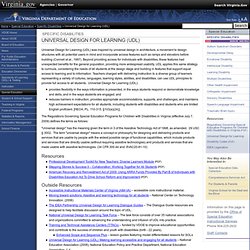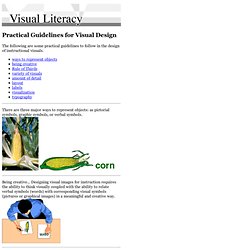

Kaitlin
I am a graduate student working towards her dream of being a middle school media specialst.
Resources for Mystery Unit. PLN. Weebly - Create a free website and a free blog. Www.temple.edu/tlc/resources/handouts/course_design/QualityMattersRubric.pdf. Blackboard Learn. Where Learning Happens. Universal Design for Learning. Universal Design for Learning (UDL) - Universal Design for Learning (UDL)
Universal Design for Learning: Meeting the Needs of All Students. National Center On Universal Design for Learning. Www.doe.virginia.gov/teaching/career_resources/stepping_stones2.pdf. Www.nationaltechcenter.org/documents/MovingTowardSolutions.pdf. Universal Design for Learning. Your browser does not support JavaScript!

This site uses JavaScript but is fully functional without it. Specific Disabilities Universal Design for Learning (UDL) was inspired by universal design in architecture, a movement to design structures with all potential users in mind and incorporate access features such as ramps and elevators before building (Connell et al., 1997). Beyond providing access for individuals with disabilities, these features had unexpected benefits for the general population, providing more widespread usability. UDL applies this same strategy to curricula, considering the needs of all students at the design stage and building in features that support equal access to learning and to information. The Regulations Governing Special Education Programs for Children with Disabilities in Virginia (effective July 7, 2009) defines the terms as follows: "Universal design" has the meaning given the term in 3 of the Assistive Technology Act of 1998, as amended. 29 USC § 3002. Museum Box Homepage.
Empressr - The Best Online Rich Media Presentation Application. Glogster EDU: A complete educational solution for digital and mobile teaching and learning. Storybird - Artful storytelling. Prezi - Ideas matter. Popcorn Maker. Animoto - Make & Share Beautiful Videos Online. VCASMO - Home. Using Audio in the Classroom. Audacity: Free Audio Editor and Recorder. Voice. SoundCloud - Hear the world’s sounds. Practical Guidelines for Visual Design. Practical Guidelines for Visual Design The following are some practical guidelines to follow in the design of instructional visuals.

There are three major ways to represent objects: as pictorial symbols, graphic symbols, or verbal symbols. Being creative... Designing visual images for instruction requires the ability to think visually coupled with the ability to relate verbal symbols (words) with corresponding visual symbols (pictures or graphical images) in a meaningful and creative way. Research on eye movement states that people from Western cultures tend to look at the upper left-hand area of a visual first. Keeping these two principles in mind it is important to place important information near the dividing lines and place the start of the main message where the eye first strikes the area.
Changes in a visual image help keep attention directed on the visual. Too much detail in a visual image can detract from instruction. Move labels close to the objects they refer to. Visual Arts: Elements and Principles of Design. The ABCs of Design. The principles of design can be thought of as a visual grammar.

Using these principles, we put together the elements of design to create effective and meaningful communication. The elements are the “what” of a design and the principles are the “how.” Using the recipe metaphor – the elements are the ingredients and the principles are the directions. Www.hu.mtu.edu/~njcarpen/hu3120/pdfs/Basic Visual Design Principles.pdf. Principles of Design. The Principles are concepts used to organize or arrange the structural elements of design.

Again, the way in which these principles are applied affects the expressive content, or the message of the work. The principles are: Balance is the concept of visual equilibrium, and relates to our physical sense of balance. It is a reconciliation of opposing forces in a composition that results in visual stability. Most successful compositions achieve balance in one of two ways: symmetrically or asymmetrically. Symmetrical balance can be described as having equal "weight" on equal sides of a centrally placed fulcrum. There is a variant of symmetrical balance called approximate symmetry in which equivalent but not identical forms are arranged around the fulcrum line.
Asymmetrical balance, also called informal balance, is more complex and difficult to envisage. Whether the solution is simple or complex, some form of balance can be identified in most successful compositions. Graphic Design Principles.